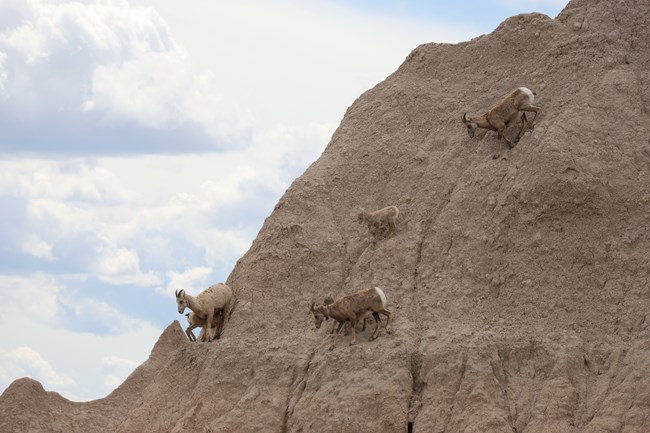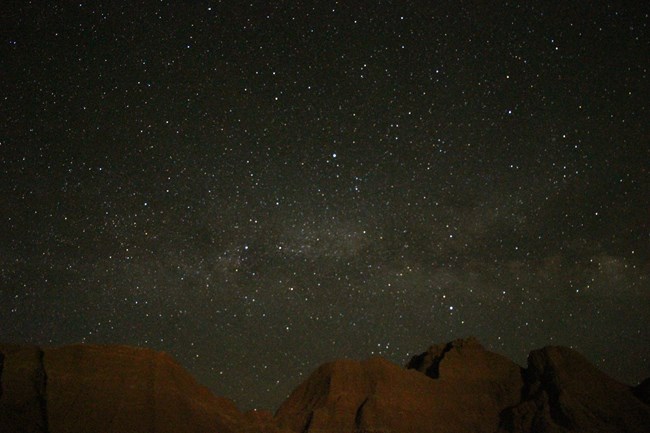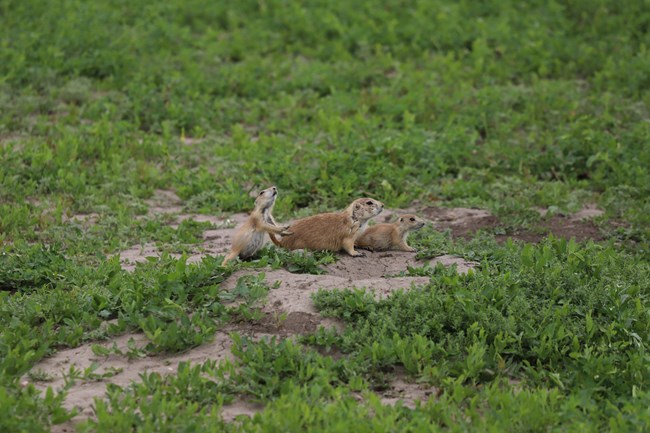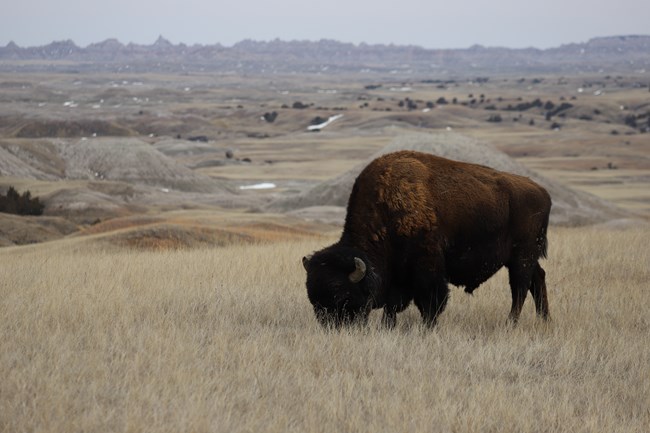Last updated: March 1, 2024
Thing to Do
Pick Your Park Adventure in the Badlands

Want to visit Badlands National Park from the comfort of your computer or phone? Interested in earning a Junior Ranger patch? Looking for some fun? You've found the right place.
Pick your park adventure through Badlands National Park, choosing where to go at the end of each scene. This activity is great for kids and can be completed digitally to earn a Junior Ranger patch.

NPS / Larry McAfee
Start your adventure below at Chapter 1. After you read Chapter 1, click on the choice you want to make and let your park adventure begin! Once you finish your adventure, be sure to try again and explore new choices. Instructions for submitting this activity as a Digital Junior Ranger Program can be found at the bottom of the page.
Chapter 1
After long hours in the car, driving through the wide-open landscapes of South Dakota and enjoying beautiful views of the Great Plains, you notice some jagged peaks in the distance. As you drive closer, you realize: You’re finally here, at Badlands National Park! Once you enter the park, there are many things to do. What first?

NPS Photo
Chapter 2
You pull up to the Ben Reifel Visitor Center and hurry inside – it’s getting hot out! When you walk in, you see rangers talking to visitors at the information desk, the park bookstore, and a sign pointing to the Fossil Preparation Lab. You can’t wait to get your visit started, so you head to…

NPS / Brad Barker
Chapter 3
You pull into a long parking lot. Many other visitors are walking around, taking pictures, and enjoying views of the Badlands formations. A woman unlocks the car next to you and mentions that she just hiked the Door Trail and the Notch Trail. She had a great time and recommended both! Which trail should you hike first?

NPS Photo
Chapter 4
At the information desk, you get to chatting with a ranger. You learn that the Badlands is rich in history, both on human and non-human timescales. The older story of the Badlands started 75 million years ago with the very oldest of Badlands rocks – the ranger tells you that if you’re interested in the geology of the Badlands, a Geology Walk will start soon on Door Trail. You also learn about the rich history of the Lakota, Native Americans who historically inhabited this land and continue to live on the Pine Ridge Indian Reservation south of the park. The ranger tells you that more information on Lakota history and culture is available at the White River Visitor Center in the South Unit of the Badlands. Where to next?

NPS / Alex Ennes
Chapter 5
The park bookstore is filled to the brim with souvenirs, books about everything relating to the Badlands, and some friendly clerks ringing purchases up. One of the clerks lets you know that all proceeds from the park bookstore go towards park programs like internships, education projects, and volunteering. With that in mind, you pick up a few postcards and head onto your next stop! Where to?

NPS
Chapter 6
Turning the corner, you see the Fossil Preparation Lab. Inside, there are fossils all around in display cabinets. You wander through, reading plaques... oreodont, subhyracodon, brontothere... Some of these animals are the ancient relatives of critters you already know, like horses, rhinos, and alligators. Others are completely new discoveries to you, like nimravid, a creature that would have lived in the Badlands around 30 million years ago and may have looked like a saber-toothed cat! You see paleontologists working on fossils. One paleontologist explains how she uses small tools to remove dirt and dust, which slowly reveals the fossil underneath. You’re very excited and she tells you that if you like paleontology, you can earn your Junior Paleontologist badge by completing a booklet and returning it to a park ranger, no matter your age!
-
You like the fossils a lot and want to learn even more. Next stop: Fossil Exhibit Trail! (Chapter 10)
-
The Fossil Preparation Lab is cool, but you want to get started on seeing more of the park. How about a drive on the Badlands Loop Road (Highway 240)? (Chapter 11)

NPS Photo
Chapter 7
Before you get started on Notch Trail, a 1.5 mile (roundtrip) trail, you double-check to make sure you have all the right gear. Sturdy boots? Check. Plenty of water? Check. Sunscreen and a hat? Check. You’re ready to go. About halfway through the trail, you come to a tall ladder scaling the formations. With a deep breath and a brave smile, you climb up! At the top, you’re immediately rewarded – you notice some dark brown teeth sticking out of the rock formations. You’ve found a fossil! You know you should report your find to the park, but you’re not totally sure what you should do. What next?
-
You’re sure you can remove the fossil safely and bring it back to the visitor center. You pull it out of the formation and head back to your car, ready to stop by the visitor center and drop your find off. (Chapter 12)
-
It’s probably best to leave it. You take a picture and make a note of your location – finally, a good use for pulling GPS coordinates from your phone! With this information, you head back to the visitor center. (Chapter 13)

NPS Photo / Larry McAfee
Chapter 8
There’s a ranger standing in front of Door Trail who explains that he’ll be leading the Geology Walk for the day. You join a group of visitors and the ranger as you embark on a journey through time, as told by the geology of the Badlands. The ranger tells you that the Badlands began forming 75 million years ago as the seafloor to the Western Interior Seaway, a shallow inland sea that used to stretch from the Gulf of Mexico to the Arctic Ocean! The younger rock layers of the Badlands represent even different environments: a swampy marshland from 38-34 million years ago and then a drier, cooler grassland from 34-28 million years ago. Over the course of millions of years, the rocks piled up in layers. Then, about 500,000 years ago, the White River and Cheyenne River started carving through the landscape and creating the jagged spires of the Badlands we know today.
-
All of this geologic history is fascinating! Next, you want to learn more about the ancient history of the Badlands at Fossil Exhibit Trail. (Chapter 10)
-
You want to get a sense of how far these Badlands formations stretch. How about a cruise on the Badlands Loop Road (Highway 240)? (Chapter 11)

NPS Photo
Chapter 9
You drive through the South Unit of the park to the White River Visitor Center. Once inside, you learn about the rich Lakota history of the Badlands area. A ranger there helps to tell the history of the Wounded Knee Massacre, in which Chief Spotted Elk used the Badlands to his advantage, avoiding the common routes taken through this challenging terrain to evade the US Army. The park ranger even tells you about more recent history, in which the US military seized parts of Pine Ridge Indian Reservation, including a part of Badlands National Park, to use as a training bombing range for the Air Force during World War II. You are amazed by these stories and ask the ranger where you can learn more. The ranger gives you some ideas, and there are two you find most interesting:
-
You want to drive up Sheep Mountain Table, the highest point in the Park, where you can get spectacular views of the South Unit on Pine Ridge Indian Reservation. (Chapter 14)
-
You want to visit Wind Cave National Park next! The ranger told you that in Lakota oral history, creation happened at Wind Cave, and you’re excited to learn more. (Chapter 15)

NPS Photo
Chapter 10
Fossil Exhibit Trail quickly becomes your favorite trail in the park! While walking the short quarter-mile boardwalk, there are little signs explaining different fossil animals that used to live in the Badlands. You learn that alligators once lived here 38-34 million years ago, and they survived the gradual cooling and drying of the Badlands environment by moving South, where it is wetter and warmer, like Everglades National Park. Other animals, like mesohippus, an ancient relative of the modern horse, adapted to the change in environment by growing longer legs to better run over wide, dry plains. You also learn that some animals, like the enormous brontothere, couldn’t adapt to the changing climate and didn’t move like the alligators did, so they went extinct. How interesting!
-
You met someone on trail who said that they saw a bunch of prairie dogs at Robert’s Prairie Dog Town – you want to go see them, too. (Chapter 16)
-
You want to visit Sheep Mountain Table, the highest elevation in the park, before you go. No time like the present! (Chapter 14)

NPS / Larry McAfee
Chapter 11
As you drive the Badlands Loop Road (Highway 240), you see badlands formations stretching out before you – you feel like they might be endless! As you turn a corner and see Prairie Wind Overlook, you notice some bighorn sheep. You researched these animals before coming to the Badlands and you share what you learned with the other visitors observing the bighorn from a distance. You tell them about the sheep with big curly horns, which are male sheep called rams. The horns on their heads can weigh a total of 60 pounds and are made out of a protein called keratin, which is the same protein our fingernails and hair are made from. Bighorn smash their horns together during mating season to fight for the right to mate with female bighorn, called ewes. As you continue your drive on the Loop Road, you think about how lucky you were to see the bighorn sheep! You come to the end of the Loop Road and find that you have two options.
-
Turn on to Sage Creek Rim Road and continue to Sage Creek Campground, where you can set up your tent and turn in for the night. (Chapter 17)
-
Stop at the final overlook on the Loop Road, Pinnacles Overlook, to enjoy the sun before it sets. (Chapter 18)

NPS Photo
Chapter 12
You return to the Ben Reifel Visitor Center and immediately see a ranger behind the information desk to help you. You excitedly run up and show them the fossil teeth you found. The ranger says, “This is a great specimen! Looks like an oreodont to me. Unfortunately, you’re not supposed to remove fossils from anywhere in the park. Their location gives our scientists important information about how old the fossil is, what kind of environment this critter may have lived in, and what other animals it might have lived with. When visitors take fossils out of the ground, they’re very well-meaning, but we miss out on this important information. It’s awesome that you found a fossil, but next time you know to leave it in place. As long as you have its location, you can fill out a Visitor Site Report and we can send paleontologists out to that spot to collect it scientifically.” Feeling newly informed, you thank the ranger for her time and step out the door, ready to do the right thing the next time you find a fossil. It’s been a long and fun day in the Badlands – where will you go for the end of your day?
-
Sage Creek Campground, to set up your tent and get ready for another adventure tomorrow. (Chapter 17)
-
Pinnacles Overlook, to catch the sunset from the highest elevation in the North Unit. (Chapter 18)

NPS Photo
Chapter 13
You return to the Ben Reifel Visitor Center and immediately see a ranger behind the information desk to help you. You excitedly run up and show them the picture of fossil teeth you found. The ranger says, “This is a great specimen! Looks like an oreodont to me. Do you have a location for this fossil?” You do! The ranger gives you a Visitor Site Report to fill out, which includes information about the fossil and its location. When you finish the ranger congratulates you on doing the right thing and leaving the fossil in place – she even gives you an “I did the right thing” patch with a nimravid skull on it! Cool! Feeling excited about your contribution to Badlands paleontology, you step out the door for your next adventure. It’s been a long and fun day in the Badlands – where will you go for the end of your day?
-
Sage Creek Campground, to set up your tent and get ready for another adventure tomorrow. (Chapter 17)
-
Pinnacles Overlook, to catch the sunset from the highest elevation in the North Unit. (Chapter 18)

NPS Photo
Chapter 14
You drive your car up a dirt road to an overlook on top of Sheep Mountain Table. The road beyond the overlook has a sign saying “High Clearance Vehicles Only.” You don’t think your SUV will make it on that dirt road, so you go on foot. As you hike out, taking in the vast views from the top of the table, night falls. Soon, you are sitting out and relaxing under the stars. Because there is little light pollution in the Badlands, you can see everything the night sky has to offer – planets, the Milky Way, even a shooting star! You have had a long, fun day exploring the Badlands and can’t wait for what tomorrow brings.
-
Thanks for taking an adventure in Badlands National Park! Learn about how you can submit this activity to become a Badlands Junior Ranger!
-
Want to try another adventure? Go back to the top of the page and to start again!

NPS Photo
Chapter 15
From the White River Visitor Center, you drive to Wind Cave National Park, which is only an hour and a half away. You tell a ranger there about your interest in Native American history and that you heard that Wind Cave plays an important part in oral history. That ranger shows you the natural entrance of Wind Cave and explains the Lakota oral history that goes along with it. In Lakota spiritual belief, Wind Cave was where the first humans emerged from underground. You are amazed by the people and forces in this oral history and spend some more time learning in their visitor center. You’ve had a long day learning about Lakota culture and heritage – you can’t wait to share what you’ve learned with others, but for now, it’s time to turn in for the night.
-
Thanks for taking an adventure in Badlands National Park – and even making it all the way out to Wind Cave National Park! Learn about how you can submit this activity to become a Badlands Junior Ranger!
-
Want to try another adventure? Go back to the top of the page and to start again!

NPS Photo
Chapter 16
You pull up to Robert’s Prairie Dog Town. There, you hear prairie dogs yipping away and there are burrows extending as far as you can see! A park ranger is there, chatting with you and other visitors. He says that prairie dogs form underground networks of burrows, where prairie dogs live, sleep, and eat. He also tells you and the other visitors that prairie dogs are important to the overall prairie ecosystem – they help trim grass for other plants to grow, churn up the soil to make good grazing areas for other animals, and are eaten by a lot of Badlands predators who depend on them for survival! One example the ranger mentions is the Black-footed Ferret, which only eats prairie dogs. The Black-footed Ferret is one of the most endangered animals in North America, and the Badlands has 120 of them, which is one of the largest populations in the world! You are amazed by this information, but the day is getting late and you need to move on. Where to next?
-
Sage Creek Campground, to set up your tent and get ready for another adventure tomorrow. (Chapter 17)
-
Pinnacles Overlook, to catch the sunset from the highest elevation in the North Unit. (Chapter 18)

NPS Photo
Chapter 17
You set up your tent in Sage Creek Campground. The campground sits next to Sage Creek, and across the creek in the distance are four bison! You remember learning about them: they can run up to 35 miles an hour, can jump 6 feet in the air, and can weigh up to 2,000 pounds. The ones you see are grazing on grass near the creek -- you’re not surprised, as bison spend 9-11 hours each day grazing! As night falls, you zip up your tent as you remember all the different things you did today. You are very glad that of all places to adventure, you chose the Badlands.
-
Thanks for taking an adventure in Badlands National Park! Learn about how you can submit this activity to become a Badlands Junior Ranger!
-
Want to try another adventure? Go back to the top of the page and to start again!

NPS Photo
Chapter 18
Here you are, at Pinnacles Overlook! While planning your trip, you read that this was the best spot to see the sunset, and that advice was correct! From this high point, Badlands stretch out in front of you and slowly melt into the beautiful green prairie in the distance. Behind them, the rich oranges, purples, and reds of the sunset paint the perfect backdrop. Thanks to the air quality at Badlands National Park, you can see for miles and even notice the outline of the Black Hills to the West. You reflect on all the amazing adventures you had today, knowing that you can’t wait to start again tomorrow.
-
Thanks for taking an adventure in Badlands National Park! Learn about how you can submit this activity to become a Badlands Junior Ranger!
-
Want to try another adventure? Go back to the top of the page and to start again!
Become a Junior Ranger
Congratulations! You just took an adventure in the Badlands and now it’s time to earn your Junior Ranger badge. Email us or send us a message on social media with three interesting things you learned on your adventure and your mailing address. Then, we will mail you your official badge and you can say your Junior Ranger pledge: “As a Junior Ranger, I promise to explore, learn about, and protect special places like Badlands National Park.” Thank you and congratulations from all the rangers at the Badlands!
